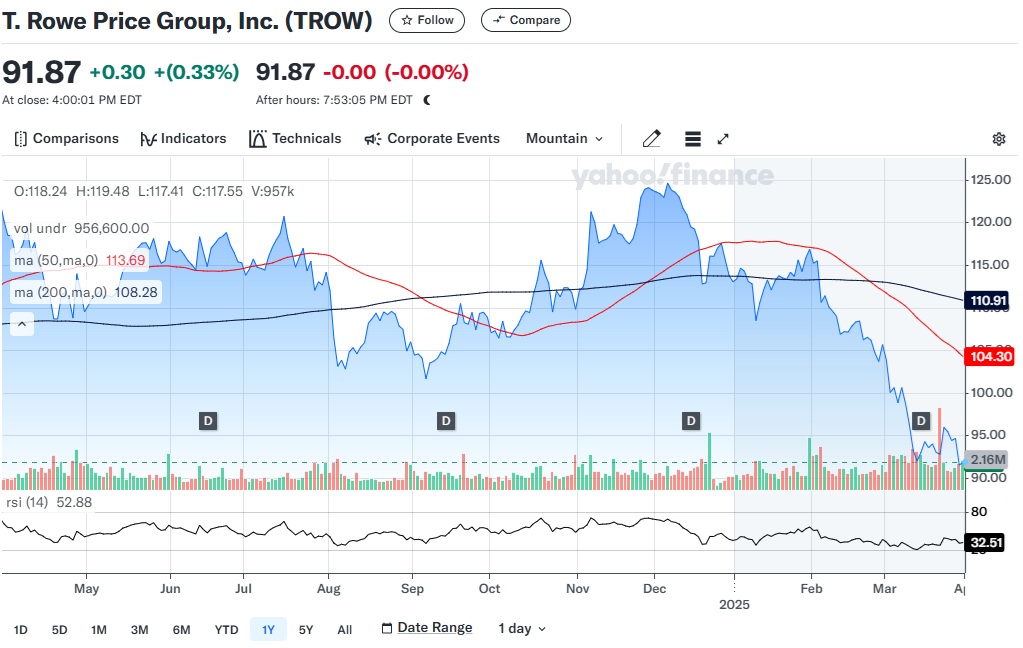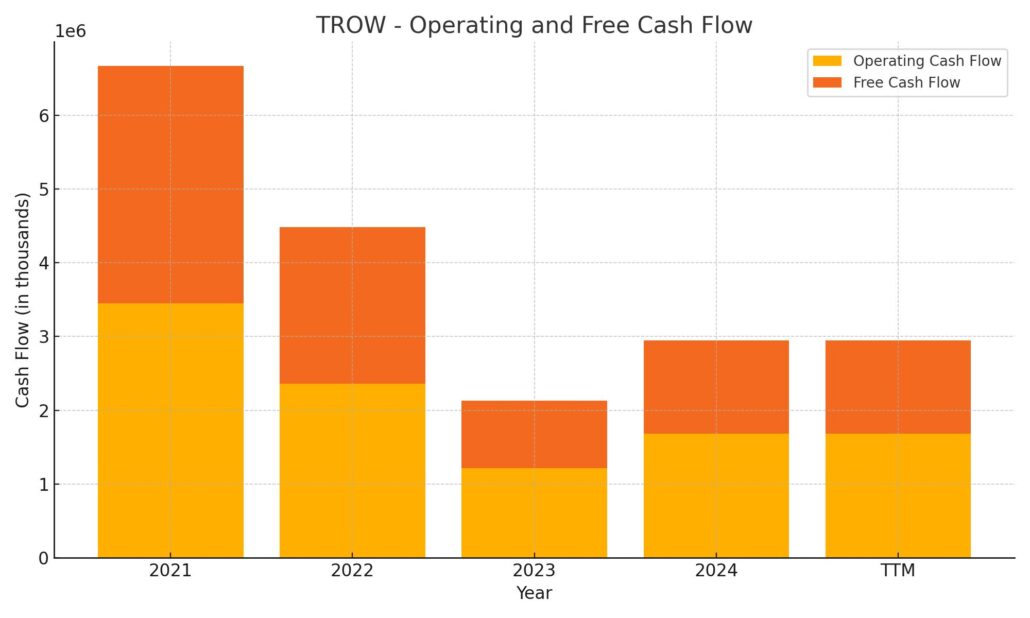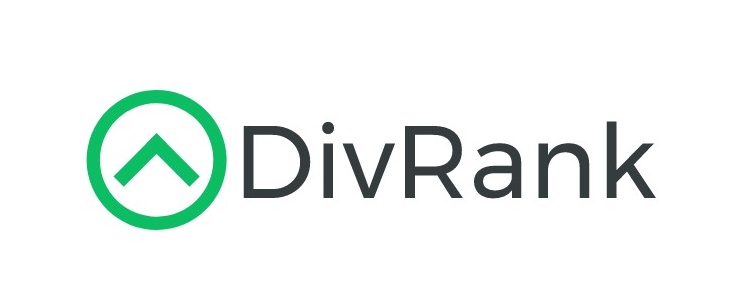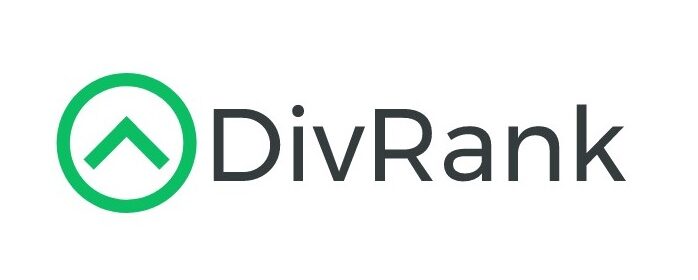Updated April 2025
Headquartered in Baltimore and founded back in 1937, the firm has earned the trust of investors by sticking to what it knows: managing money and delivering consistent returns.
What makes T. Rowe stand out for dividend investors isn’t just its long history—it’s how it treats shareholders. Through bull markets, bear markets, and everything in between, TROW has consistently paid and grown its dividend. That kind of reliability isn’t common these days, especially with the financial sector facing pressure from all angles. But T. Rowe isn’t trying to reinvent the wheel—it’s quietly doing what it does best and paying investors to be patient.
Let’s walk through what’s happening at TROW right now and why income-focused investors might want to keep an eye on this one.
Recent Events
Over the past year, it’s been a bit of a grind for T. Rowe. The stock has pulled back sharply, dropping about 24% from its high. It’s currently trading around $91.87—just a few bucks above its 52-week low. With the S&P 500 heading higher, this kind of underperformance might raise some eyebrows, but there’s more to the story.
Revenue for the trailing twelve months came in at $7.09 billion, up over 11% from the year before. Net income growth was more muted at just 0.5%, but the underlying profitability remains strong. The company is still generating margins that many other firms would envy—operating margin is just under 33%, and profit margin is almost 30%.
Valuation has also come down quite a bit. TROW now trades at just 10 times earnings, and its forward P/E is even lower. For a company with this kind of balance sheet and cash flow profile, those multiples are starting to look pretty compelling.
Key Dividend Metrics
📈 Forward Yield: 5.53%
💵 Annual Dividend: $5.08 per share
📆 Dividend Growth Streak: 37 years
📊 Payout Ratio: 54.21%
🔋 Free Cash Flow (ttm): $1.69B
🏦 Cash on Hand: $2.65B
📉 5-Year Average Yield: 3.53%
📈 Recent Dividend Increase: From $4.96 to $5.08
🔒 Debt/Equity: 2.95%
Dividend Overview
T. Rowe’s dividend yield is doing more than just keeping up—it’s leading the pack. At over 5.5%, it’s not only well above its five-year average but also ahead of many peers in the asset management space. That kind of yield doesn’t happen overnight. It’s the result of years of discipline, cash generation, and a management team that’s clearly aligned with long-term shareholders.
What’s important here is that the dividend isn’t just big—it’s stable. The company increased its payout again recently, from $4.96 to $5.08 annually. That might not seem like a dramatic bump, but it’s a signal. T. Rowe’s board isn’t just maintaining the payout to keep investors quiet—they’re actively growing it even when market conditions aren’t ideal.
The payout ratio sits at a comfortable 54%. That’s right in the sweet spot for a mature company. It means there’s still room to invest in the business or handle short-term earnings dips without having to touch the dividend. That kind of breathing room is what separates a sustainable dividend from one that’s always hanging by a thread.
And it’s not just about income. When a company like TROW has more than $2.6 billion in cash and barely any debt—just $338 million—it tells you something. This is a fortress balance sheet. Even if earnings slowed, there’s plenty of cushion to keep those payments coming.
Dividend Growth and Safety
This is where T. Rowe Price really earns its stripes. Not only is the yield attractive today, but the growth behind it has been incredibly consistent. For 37 straight years, the dividend has gone up. That kind of track record puts it in rare company. It’s not easy to deliver that kind of consistency—especially in a business where earnings are tied to market swings.
Over the last decade, TROW’s dividend has grown at a double-digit annual pace. More recently, growth has slowed, reflecting a more cautious approach as market conditions remain volatile. But even a more modest pace still speaks volumes. Management isn’t backing off—it’s just being responsible.
That payout ratio, again, is key. At 54%, it leaves T. Rowe in a strong position. The firm isn’t overreaching, and it’s got the flexibility to adjust without risking the dividend. Add in the fact that it’s generating $1.69 billion in free cash flow annually, and the dividend practically pays for itself.
Then there’s the balance sheet. A company with almost no debt and a mountain of cash is hard to find. T. Rowe’s debt-to-equity ratio is under 3%. For context, most firms in the sector are well into the double digits. This kind of financial strength gives the dividend an extra layer of security.
When you add it all up—strong yield, consistent growth, a safe payout, and zero debt worries—it paints a clear picture. T. Rowe Price isn’t just paying a dividend. It’s treating the dividend like a core part of the business, not just a quarterly obligation. And for income-focused investors, that mindset makes all the difference.
Chart Analysis

Current Position and Overall Trend
Looking at the past year of price movement, the stock has clearly transitioned out of a topping structure and is now in a prolonged downtrend. After peaking near $125 in December, the price has steadily declined, slipping below both the 50-day and 200-day moving averages. As of now, it’s trading around $91.87, well below the 200-day MA of $108.28 and even further beneath the 50-day MA of $113.69. The moving averages themselves are sloping downward, which reinforces the bearish trend that has taken hold over the past few months.
Market Cycle Stage
This chart shows clear signs of entering the markdown phase. After a distribution zone that built up between November and February, where the stock repeatedly failed to break higher and volume started showing more selling interest, the price gave way and started trending lower in a structured decline. We’re now deep into the markdown leg, with support levels getting tested around $90 and resistance forming between $95 and $100.
Volume spikes around each drop confirm increased selling pressure. Notably, volume surged as the price slipped through $100, a psychologically important level, further confirming the markdown momentum.
Volume Activity
Volume offers several clues here. During the earlier stages of the decline—especially around early March—volume increased significantly. That’s often a sign of institutional distribution, not just retail panic. In recent days, volume has stayed elevated but not at capitulation levels, which suggests this phase may still have room to unfold. We’re not seeing a classic selling climax yet.
That said, today’s volume of 2.16 million shares is almost double the average daily volume from the middle of the chart, and the last few candles have come with a small bounce, which could mean early bargain-hunting is beginning—but it’s too soon to call it anything more than that.
Relative Strength Index (RSI)
The RSI has been hanging in bearish territory for a while now. It recently touched the 32 level, nearly oversold, and has rebounded slightly to 52.88. This bounce back toward the midpoint shows some short-term recovery, but with the price still below both major moving averages and downward momentum in place, it likely represents a short-term pause rather than a full reversal.
RSI movements in this range often show bear market rallies rather than new trends forming. Until we see sustained movement back above 60 or 70 with price confirmation, it remains a signal of temporary relief.
Recent Candles and Price Action
The last five candles are interesting. Here’s the breakdown:
- The first three show narrow bodies with long wicks on both ends—classic signs of indecision and tug-of-war between buyers and sellers.
- The fourth candle shows a sharp move higher but on lower volume than the surrounding days. It’s a bounce, but not one backed by conviction.
- Today’s candle closed flat, showing buyers couldn’t push it further even after a green open. This hints that selling pressure may still be lurking just overhead.
Wicks on the upside, especially when appearing more than once in a row, often reflect failed attempts to rally, met with persistent overhead supply.
Technical Summary
The chart is showing all the textbook signs of being in a markdown phase, coming off a prolonged distribution zone. The steady decline below major moving averages, confirmed by elevated selling volume and hesitant recent candles, points to a market that’s still trying to find a real floor. There may be short-term rebounds here and there, but the broader trend is still down.
Until the stock reclaims its 50-day or 200-day moving averages with meaningful volume support, the path of least resistance remains lower.
Analyst Ratings
📊 Recent assessments of T. Rowe Price Group (TROW) reflect a cautious but steady stance among analysts. The average 12-month price target sits around $108.23, which suggests some upside potential from where the stock is currently trading.
🧐 In February 2025, several firms updated their outlooks on TROW:
🏦 Morgan Stanley trimmed its price target from $126 to $121 while keeping an “Equal-Weight” rating. This shift reflects a more balanced view of the firm’s valuation relative to industry headwinds.
📈 Keefe, Bruyette & Woods nudged their target slightly higher, moving from $111 to $113 and sticking with a “Market Perform” rating. They acknowledged the company’s financial resilience but kept expectations in check.
📉 Wells Fargo adjusted its target downward from $118 to $116, also holding firm with an “Equal-Weight” rating. Concerns around asset flow challenges and expense pressures were cited in the move.
📉 Barclays went a bit more bearish, reducing their target from $113 to $105 while maintaining an “Underweight” rating. Their call appears tied to ongoing pressure in active management and fee-based revenue models.
🎯 Overall, the ratings reflect a consensus that’s neither glowing nor alarmist—just a level-headed assessment of a company navigating a maturing business environment.
Earning Report Summary
A Snapshot of the Quarter
T. Rowe Price ended 2024 with results that were steady, if not spectacular. Assets under management came in at $1.61 trillion, just a touch below the previous quarter’s $1.63 trillion. That small dip doesn’t tell the whole story, though. The company did see net outflows of $19.3 billion in the fourth quarter, which added up to $43.2 billion for the year. That’s not a number you want to see climbing, but it’s also not entirely unexpected in a market where investors are being more cautious and selective.
Despite those outflows, T. Rowe’s foundation is still firm. The company knows how to navigate tough environments, and they’ve been through enough cycles to not get rattled by a single year of pullback.
Earnings and Efficiency
Earnings per share for the fourth quarter landed at $1.92, bringing the total for the year to $9.15. That’s down from the previous year, but it’s still a healthy level of profitability. With fee compression and more money flowing into passive products, it’s not surprising that margins are under a little pressure. Even so, the company’s operational muscle remains strong.
T. Rowe also did a solid job managing expenses. Operating costs were kept in check, even as they invested more in technology and hiring. It’s clear they’re not standing still—they’re putting money into areas that could help them stay competitive and relevant.
Looking Ahead
All in all, this earnings report was a reminder that while the company isn’t immune to industry headwinds, it still has control over what it can manage—costs, strategy, and focus. The numbers weren’t blowout figures, but they show a company that’s still highly profitable, even while adjusting to a shifting landscape. For a business built on long-term thinking, this was a measured step forward in a year that demanded just that.
Balance Sheet Analysis
T. Rowe Price continues to show why boring can be beautiful. As of the end of 2024, total assets climbed to $13.47 billion, up from $12.28 billion the year prior, reflecting consistent and steady expansion. Meanwhile, liabilities barely nudged past $2 billion—almost suspiciously well-behaved in today’s market. That leaves equity at a strong $11.45 billion, a solid buffer that speaks to the firm’s capital discipline and long-term stability.
Debt? Blink and you’ll miss it. Total debt stands at just $278 million, which, for a company this size, is like owing a few bucks to a friend for lunch. Net tangible assets and tangible book value both grew year over year, adding more weight to the company’s underlying value. Working capital also pushed past $3 billion, giving TROW plenty of room to operate comfortably. With capital lease obligations slowly drifting downward and equity per share rising, the company continues to look like a fortress—less flashy, more focused, and clearly built to last.
Cash Flow Statement
T. Rowe Price’s cash flow over the trailing twelve months tells the story of a company staying disciplined during a tighter operating environment. Operating cash flow came in at $1.69 billion, a nice jump from the previous year’s $1.22 billion but still well below the levels seen in 2021. Free cash flow also landed at $1.26 billion, showing that even with elevated capital expenditures of $423 million, there’s still healthy breathing room. While the cash machine isn’t roaring like it once did, it’s humming along just fine.

On the investing side, the outflow was modest at $177 million, mostly tied to capital spending. Financing cash flow was solidly negative at $937 million—no surprises there, given ongoing dividend payouts and share repurchases. Speaking of buybacks, TROW spent $337 million retiring shares, although that’s lighter than the billion-dollar pace from just two years ago. End-of-period cash hit $2.71 billion, nearly $1.1 billion more than two years ago. In short, they’re not lighting cash on fire, but they’re not hoarding it under the mattress either. It’s a tidy, efficient setup—one that shows T. Rowe knows how to manage capital without drama.
Management Team
T. Rowe Price has long been associated with thoughtful, deliberate leadership—and that hasn’t changed. CEO Rob Sharps, who took the reins in 2022, is a firm veteran with nearly three decades at the company. He’s not a hired gun from outside, but someone steeped in the firm’s culture and long-term investment philosophy. That’s no small detail. In a space where high turnover and short-termism are common, T. Rowe’s leadership bench has consistently emphasized continuity, discipline, and client-first values.
The broader leadership team is similarly seasoned. From the CIO level down through operations and risk management, the tone is steady, measured, and focused. There’s a strong emphasis on internal promotion, which helps maintain a consistent strategic outlook. While it may not make for thrilling headlines, this is a team that knows what it’s doing and isn’t likely to veer off course chasing short-term gains or market fads.
Valuation and Stock Performance
At around $91, TROW is trading well below its highs from the past couple of years. It’s down nearly 24% over the last 12 months and sitting closer to its 52-week low than its high. That’s clearly a drag on paper, but it also brings valuation into a zone that’s hard to ignore. The stock is now trading at roughly 10 times trailing earnings and even less on a forward-looking basis. These aren’t lofty multiples—we’re talking more old-school value than anything.
The market seems to be pricing in a slowdown in asset growth, tighter margins, and a more challenging fundraising environment. Fair enough. But when you pair that with a strong balance sheet, a reliable dividend, and solid free cash flow, it starts to feel like sentiment might be a little too gloomy. The stock’s long-term performance has historically outpaced broader benchmarks over extended periods, and while the current environment is more challenging, the fundamentals remain solid. It’s more of a waiting game than a sprint right now.
Risks and Considerations
The biggest headwind facing T. Rowe Price is industry-wide: fee pressure in asset management continues to build. As more investors shift toward lower-cost passive strategies, traditional active managers like TROW have to work harder to justify their fees. There’s also the persistent risk of market downturns, which directly impact assets under management and, by extension, revenue.
Technology and innovation are another area to watch. While T. Rowe has been investing in digital platforms and distribution channels, it’s not a tech-first company—and that could become a vulnerability as younger investors and institutions increasingly expect seamless digital interfaces and data-driven personalization. And finally, global macro uncertainty—from interest rate shifts to geopolitical instability—can all ripple through the markets and affect flows, sentiment, and overall performance.
Final Thoughts
T. Rowe Price isn’t going to win any popularity contests with fast-money traders, and it’s not chasing headlines or buzz. What it does offer is a sense of grounded reliability—a seasoned management team, a fortress balance sheet, consistent cash flows, and one of the most enduring dividend stories in the market. While the stock has stumbled in recent quarters, the fundamentals haven’t crumbled. If anything, the current price reflects a cautious market mood rather than a broken business model.
In a world where so many companies try to be everything at once, TROW’s ability to stick to its core strengths—and return capital along the way—makes it worth a second look.

